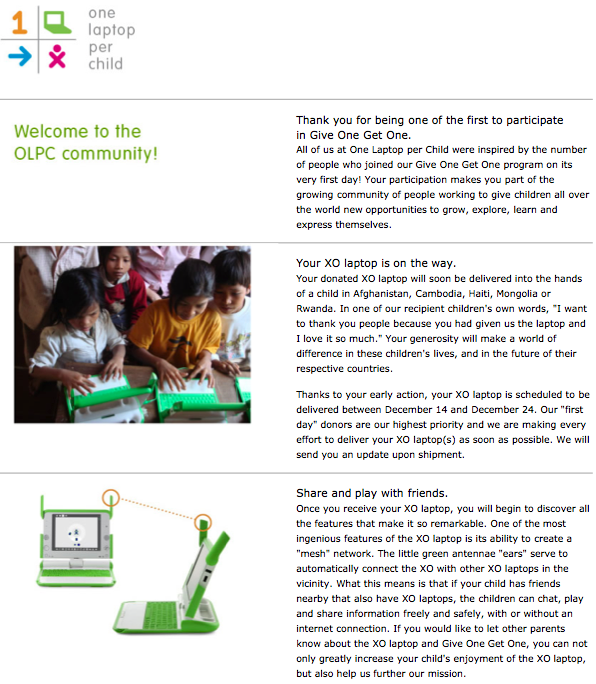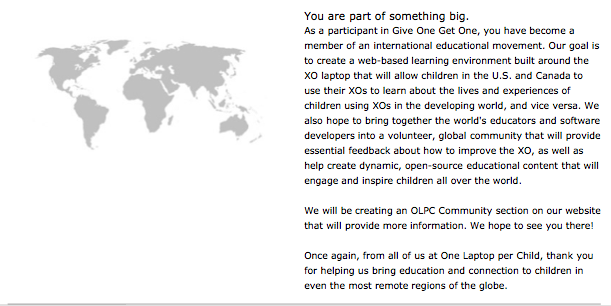Many recipients of the One Laptop Per Child (OLPC) Give One, Get One (G1G1) program in the US and Canada are starting to receive their XO laptops. This means people are starting to join forums and write about their experiences. That’s all terrific, but it’s important to remember that the intended 3rd world audience is very different than the lives of most of the G1G1 users. Here’s my public service attempt to create a reminder checklist for potential XO reviewers.
After the checklist, please enjoy my nomination for The Worst XO Review Ever…
G1G1 XO Top Ten Pre-Review Checklist
1. You aren’t the customer. Remember who this is made for. It’s not you, or even the child you hand it to to “try out.” Check the OLPC Wiki for some of the reports from the field. Try to remember that you and most likely your child have pre-conceived notions and advantages that you don’t realize. You are like a fish trying to ignore water.
2. Keep the stage of the project in mind. Are you used to being on the bleeding edge? Do you download alpha applications and help the developers track bugs? Do you “get under the hood” of your operating system or do any programming? Have you ever participated in an open source community or even edited Wikipedia? If that’s not your typical MO, take a second look before you complain about bugs, features that haven’t been implemented, or features that you think are essential. It’s going to crash, it’s going to have bugs, and you will probably have to do some detective work to figure things out, including how to keep it up to date. Having to go to terminal mode is not a failure of the design; for best results, think of it like a new adventure.
3. It’s not a “cheap” version of your laptop. Low cost was a design driver for the XO, but not the only one. Cheap is expensive if the laptop breaks in harsh conditions.
4. The collaboration features will seem broken and lackluster. It’s like playing volleyball by yourself - don’t be surprised if the ball doesn’t jump back over the net by itself. It doesn’t mean your ball is broken or the game of volleyball is poorly designed. The answer is that it’s not really volleyball without the rest of the team. In your case, the XO may seem as useful as half a zipper without a local community of users.
5. The operating system (OS) is young. The Sugar OS is a custom design that has different goals than Mac, Windows, or even Linux. Sugar was created to support a collaborative, constructive educational environment AND 3rd world conditions AND unique hardware. Decisions were made that may seem odd to you, but potentially make a lot of sense in that context. The OS will evolve. See this Tom Hoffman post for more details.
6. Your in-home wireless network with a fat pipe Internet connection is an anomaly. Let’s not start whining that you can’t stream episodes of The Office.
7. Your customer support is not a priority. OLPC created the G1G1 opportunity for a limited time with no plans to go into the business of shipping to and supporting individual American customers. If you want great tracking and toll-free support phone lines, call Amazon. It was clear from the G1G1 website that these computers came with NO TECH SUPPORT. I don’t want OLPC to waste their money hiring people to track packages, I would rather that money went to improve delivery to kids in the developing world. Of course you should get what you paid for. But look, if I pledge my local PBS station and get a coffee cup, I don’t expect perfect shipping and tracking either. You got your tax deduction and a cool invention. Enjoy them.
8. Your child is not the intended audience either. Giving the XO to your child and watching them struggle through the interface and applications does not “prove” that the laptop was poorly designed or that the constructivist philosophy of learning is a failure. The XO was built for children in a group, using it day in and day out at home and school, hopefully with adults around who can help guide them in educational pursuits. The concept of “neighborhood” is not a metaphor. Imagine kids sitting next to you, looking at what you do and saying, “hey, that’s cool, how did you do that?” The primary collaboration happens around the computer, not through the computer. It also happens because the use is expected and ubiquitous, not something squeezed in for 15 minutes on a Thursday night between homework, ballet and soccer practice. Your child’s XO experience will likely be lonely and frustrating. However, I predict a handful of kids will take to it like a duck to water. If you have one of these, say hello to your future programmer.
9. The mesh network is trying to do things you don’t need. The innovative mesh networking allows the XO computers to collaborate even when there is no Internet connection, or to share a single connection with others. In your home, it’s primarily going to suck your battery dry. As I used to say a lot when I was a programmer, “it’s a feature, not a bug!”
10. Last but not least - you and 150,000 other people did an amazing, generous thing and should be congratulated. The G1G1 program sent 150,000 laptops (Laptop Magazine) to homes in the US and Canada. People paid double to get an untested invention with no promise of any kind of support. As a direct result of this, 150,000 more children around the world got an XO laptop. My checklist may seem overly negative, but it’s only because I’m reacting to some early reports and anticipating others. The conversation around the XO is enhanced by all of our participation, but I hope people give it a fair shake and remember the true purpose of the XO. It’s going to take some time and some pain. It’s not perfect, but it’s a step in the right direction. I hope some of you get inspired to get into the guts of the thing and have some of the fun I used to have in the 70′s building computer kits and programming in octal. It’s the best!
And now, for your enjoyment, the worst XO review ever…
This review from The Economist, One Clunky Laptop Per Child would be laughable if it weren’t being read by “a global audience of senior business, political and financial decision-makers.” Surrounded by ads for first class travel, the article predictably complains about the difficulty of installing Flash to watch YouTube videos and not getting minute by minute shipping status on the package.
The “keys are too small” and don’t feel right. After using it an entire week, the writer experienced “occasional crashes.” And horror of horrors, “A discreet message sometimes flashes when the system boots up, warning of some sort of data-check error.”
The fact that XO has generated competition from other computer manufacturers who have suddenly woken up to the low cost laptop market is listed as a problem. And even stranger, the “hubris” of OLPC developers is mentioned. I guess OLPC developers aren’t supposed to be proud of their innovations or defend their decisions. What silliness.
My parting shot…
The Economist Looks At OLPC XO
 Illustration: The Modern Living Room by Humphrey Weston. (slightly altered)
Illustration: The Modern Living Room by Humphrey Weston. (slightly altered)
Sylvia
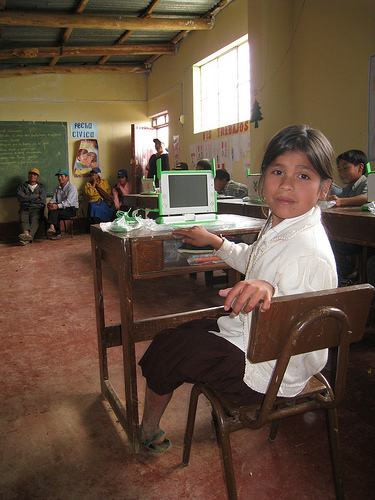

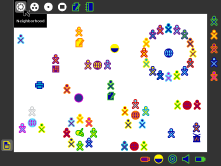 A: There are technical details
A: There are technical details
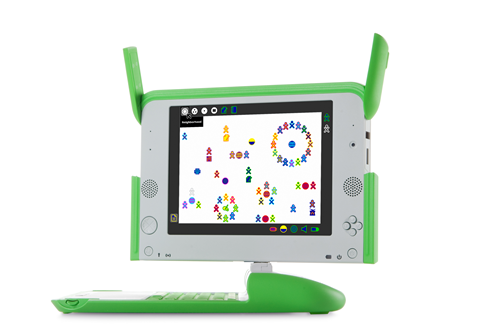
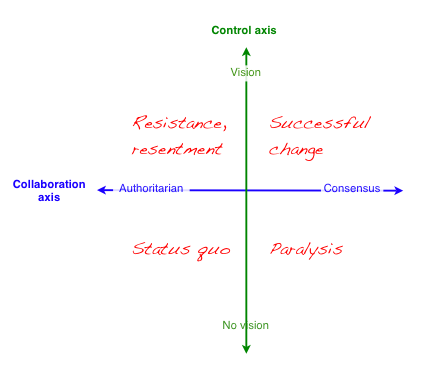
 Illustration:
Illustration:  John Dvorak (PC Magazine) recently wrote a column called
John Dvorak (PC Magazine) recently wrote a column called  Using children as the focal point for change is an innovative (and controversial) aspect of OLPC. Some detractors have ridiculed this as meaning that teachers aren’t important or necessary. Yet this is far from true. It’s simply not an either/or situation. In my recent post,
Using children as the focal point for change is an innovative (and controversial) aspect of OLPC. Some detractors have ridiculed this as meaning that teachers aren’t important or necessary. Yet this is far from true. It’s simply not an either/or situation. In my recent post,  Consider this Peruvian XO pilot project in Arahuay, a poor, rural town in the Andes. This project was profiled in the Washington Post, Dec. 30, 2007
Consider this Peruvian XO pilot project in Arahuay, a poor, rural town in the Andes. This project was profiled in the Washington Post, Dec. 30, 2007  and then fabricate it using techniques found online. Maybe they will communicate with a rural Cambodian village that successfully built a wind-powered electrical generator and build one for themselves. One day not far in the future, a ten year old might save his mother’s life with medical information found online. Today Saida is making a video about her village, tomorrow she could be running for public office using video to communicate her message.
and then fabricate it using techniques found online. Maybe they will communicate with a rural Cambodian village that successfully built a wind-powered electrical generator and build one for themselves. One day not far in the future, a ten year old might save his mother’s life with medical information found online. Today Saida is making a video about her village, tomorrow she could be running for public office using video to communicate her message.
 These kids are smart, creative and in the understatement of the century, have a world of authentic problems to solve. Plus, there are caring adults who could help if given the chance. The least the “developed world” can do is give kids, their parents, and teachers access to the most powerful intellectual amplifier ever invented - the computer, and a connection to the world of information and expertise.
These kids are smart, creative and in the understatement of the century, have a world of authentic problems to solve. Plus, there are caring adults who could help if given the chance. The least the “developed world” can do is give kids, their parents, and teachers access to the most powerful intellectual amplifier ever invented - the computer, and a connection to the world of information and expertise.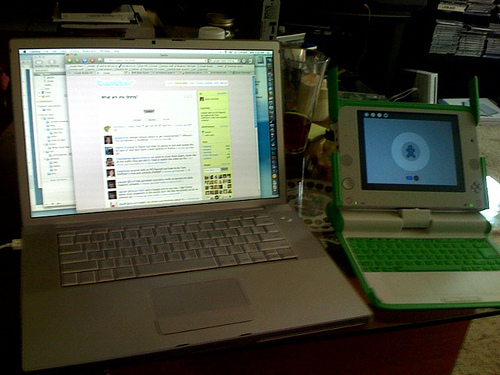 My networks helped me out. I read Tom’s post, and
My networks helped me out. I read Tom’s post, and 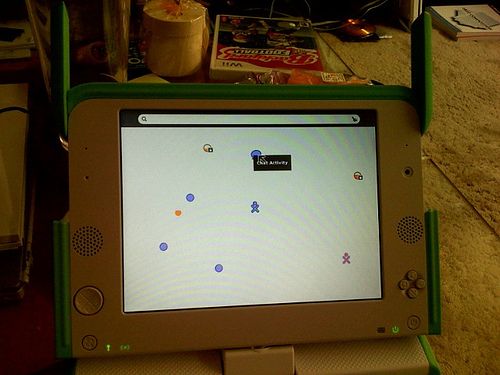

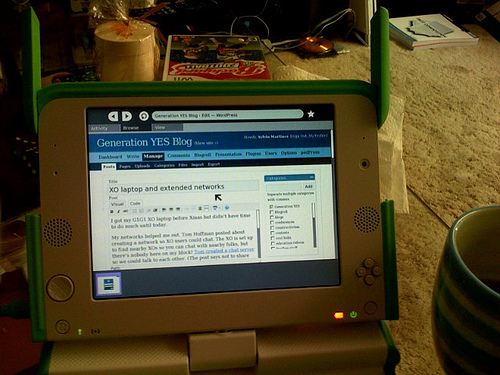 By the way, today is the LAST DAY to
By the way, today is the LAST DAY to 